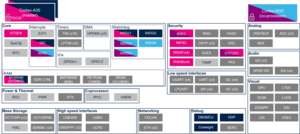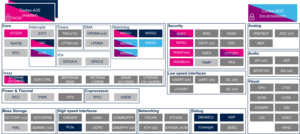1. Article purpose[edit | edit source]
The purpose of this article is to:
- briefly introduce the GPU peripheral and its main features,
- indicate the peripheral instances assignment at boot time and their assignment at runtime (including whether instances can be allocated to secure contexts),
- list the software frameworks and drivers managing the peripheral,
- explain how to configure the peripheral.
2. Peripheral overview[edit | edit source]
The GPU peripheral is a dedicated graphics processing unit. It accelerates numerous 3D graphics applications such as graphical user interface (GUI), menu display or animations. It works together with an optimized software stack designed for industry-standard APIs and supporting AndroidTM and Linux® embedded development platforms (read the STM32 MPU reference manual [1] for more details).
2.1. On STM32MP15x lines  [edit | edit source]
[edit | edit source]
The GPU peripheral main API supports are:
- OpenGL® ES 1.1 and 2.0
- OpenVG® 1.1
- EGL™ 1.4
Refer to the STM32 MPU reference manuals for the complete list of features, and to the software frameworks and drivers, introduced below, to see which features are implemented.
2.2. On STM32MP23x lines  and STM32MP25x lines
and STM32MP25x lines  [edit | edit source]
[edit | edit source]
The GPU peripheral provides a powerful hardware acceleration means for all modern Graphic, but also Neural, and general parallel computing applications.
Main API are the same as on STM32MP15x lines ![]() , with the following extra ones:
, with the following extra ones:
- OpenGL® ES 3.2.8 (backward compatible: OpenGL® ES 2.1 & OpenGL® ES 1.1)
- Vulkan 1.3
- OpenVG® 1.3
- OpenCL® 3.0
- OpenVX® 1.3
Refer to the STM32 MPU reference manuals for the complete list of features, and to the software frameworks and drivers, introduced below, to see which features are implemented.
3. Peripheral usage[edit | edit source]
This chapter is applicable in the scope of the OpenSTLinux BSP running on the Arm® Cortex®-A processor(s), and the FwST-M Package running on the Arm® Cortex®-M processor.
3.1. Boot time assignment[edit | edit source]
The GPU peripheral is not used at boot time.
3.2. Runtime assignment[edit | edit source]
3.2.1. On STM32MP15x lines  [edit | edit source]
[edit | edit source]
Click on ![]() to expand or collapse the legend...
to expand or collapse the legend...
| Domain | Peripheral | Runtime allocation | Comment | |||
|---|---|---|---|---|---|---|
| Instance | Cortex-A7 secure (OP-TEE) |
Cortex-A7 nonsecure (Linux) |
Cortex-M4 (STM32Cube) | |||
| Visual | GPU | GPU | ☐ | |||
3.2.2. On STM32MP23x lines  [edit | edit source]
[edit | edit source]
The table below is applicable to any TD flavor (A35-TD or M33-TD) ![]() .
.
Click on ![]() to expand or collapse the legend...
to expand or collapse the legend...
| Domain | Peripheral | Runtime allocation | Comment | ||||
|---|---|---|---|---|---|---|---|
| Instance | Cortex-A35 secure (OP-TEE / TF-A BL31) |
Cortex-A35 nonsecure (Linux) |
Cortex-M33 secure (TF-M) |
Cortex-M33 nonsecure (STM32Cube) | |||
| Visual | GPU | GPU | ⬚OP-TEE | ☐ | ⬚ | ⬚ | |
3.2.3. On STM32MP25x lines  [edit | edit source]
[edit | edit source]
The table below is applicable to any TD flavor (A35-TD or M33-TD) ![]() .
.
Click on ![]() to expand or collapse the legend...
to expand or collapse the legend...
| Domain | Peripheral | Runtime allocation | Comment | |||||
|---|---|---|---|---|---|---|---|---|
| Instance | Cortex-A35 secure (OP-TEE / TF-A BL31) |
Cortex-A35 nonsecure (Linux) |
Cortex-M33 secure (TF-M) |
Cortex-M33 nonsecure (STM32Cube) |
Cortex-M0+ (STM32Cube) | |||
| Visual | GPU | GPU | ⬚OP-TEE | ☐ | ⬚ | ⬚ | ||
4. Software frameworks and drivers[edit | edit source]
Below are listed the software frameworks and drivers managing the GPU peripheral for the embedded software components listed in the above tables.
- Linux®: OpenGL® ES framework
| Add a link to "GPU framework overview" article when available. |
5. How to assign and configure the peripheral[edit | edit source]
The peripheral assignment can be done via the STM32CubeMX graphical tool (and manually completed if needed).
This tool also helps to configure the peripheral:
- partial device trees (pin control and clock tree) generation for the OpenSTLinux software components,
- HAL initialization code generation for the STM32CubeMPU Package.
The configuration is applied by the firmware running in the context in which the peripheral is assigned.
See also additional information in the GPU device tree configuration article for Linux®.
6. How to go further[edit | edit source]
Please go through the articles belonging to the GPU category.
7. References[edit | edit source]
- ↑ STM32 MPU reference manuals for more details


